Answers to discussion topic questions in Unit 5
Please make sure you understand the answers before you attempt the practice
quiz or unit test. Many of these answers came from your fellow students.
Engines
- Perhaps you have seen references in commercials for
trucks with a "hemi". What exactly is a "hemi" and what are the
advantages of having one?
The hemispherical combustion chamber was the
design that Chrysler made legendary in the “426 HEMI” motor. In the standard
cylinder head design, the intake and exhaust values are on one side and the
spark plug is on the other. The chamber is relatively flat and
asymmetric. The "hemi" has a domed shape head with values on
opposite sides (the spark plug is in the center). Since the valves are
located opposite from each other, their
overall size can be increased since
there is reduced risk of collision.
This increases power because there is
greater fuel flow through the cylinder.
The increased valve area means heat can escape easier, allowing a higher overall
pressure. This increases efficiency. Another advantage of the hemi
deals with the overall surface area of the entire combustion chamber.
A HEMI actually has less overall surface area than a conventional flat head
engine. As a result, less heat is lost via conduction, resulting in a
chamber that burns hotter and more efficiently.
-
Many automakers like GM are trying SIDI technology in
their engines. What does this acronym stand for? Briefly explain how this
system differs from a conventional 4 stroke engine. What are the advantages
of using this technology?
In a conventional 4 stroke engine,
the fuel and air are mixed together before they enter the cylinder. SIDI
stands for Spark
Ignition
Direct
Injection.
In some ways it is much like a diesel engine where the fuel is injected
directly into the cylinder. This allows a higher compression ratio which
translates to more power. However, a spark plug is still used to ignite the
air/fuel mixture.
-
The gas expelled by your car engine is still capable of
performing useful work. Has anyone found a way to utilize this hot, high
pressure exhaust gas to serve a purpose?
In an effort to reduce harmful nitrogen oxide emissions,
a portion of the exhaust is recirculated back to the cylinder. This aids
in lowering the overall emission of these gases. The device known as an EGR (exhaust gas recirculation) is found in most gasoline and diesel engines.
Race cars and high performance sports cars have
turbochargers. Energy of the exhaust gas can used to create rotational
force to a turbine as it flows to the car's exhaust. This turbine powers a
compressor that compresses fresh air from the air intake. Compressed air gets
very hot and can cause detonation in an internal combustion engine. This
compressed air gets sent to an intercooler to be cooled off before entering
the cylinder. Compressing the air means more air can enter the cylinder at one
time which in turn means more fuel can enter too. More air plus more fuel
equals bigger boom which translates to more power (torque too).
BMW has found a way to use the “wasted energy” from exhaust gases. Initially
used by NASA, a thermoelectric generator (remember thermocouples in unit 3?)
converts heat into electricity, which can be stored for later use. Until
recently, it was not considered useful in automotive applications. But
technology has improved, and some are capable of generating 600 watts of
electric power. BMW uses the TEG in the exhaust system to generate electric
current, which could be used to heat the passenger compartment of the vehicle.
BMW is also working on a "turbosteamer"
which is a miniature version of a power station. Exhaust heat turns a
substance to steam which then spins a turbine. This energy can be used
to help drive the engine or produce electricity.
Diesel engines can make use of exhaust gasses to slow the vehicle down in a
process called Exhaust Braking. Basically a value restricts
the flow of exhaust gasses to the atmosphere, building up back-pressure.
Now instead of the piston easily pushing gasses out during the exhaust cycle,
it has to work much harder. This can provide enough "stopping power" so
that the vehicle might not need to use the system brakes at all on a steep
downgrade. In a similar process, a diesel can use Jake Braking to
slow a loaded truck going downhill. Here the exhaust value is opened at
the end of the compression stroke (with no ignition). Now the engine is
compressing gasses (using energy) with no subsequent energy return via
combustion. This produces a very noisy sound you might have heard from
trucks trying to slow down on a steep downgrade or needing to stop suddenly.
Another student wrote: Someone did find a way to utilize the hot, high
pressure exhaust gas. An exhaust
air jack.
Another student wrote: Research is being done at
Purdue University to convert the heat that is given off by car's exhaust
into electricity using the concept of thermoelectric generators. Note:
We discussed thermoelectric generation in an earlier unit when we covered
thermocouples. However, instead of using bimetallic junctions, these
newer generators use semiconductor junctions to produce electricity.
- List two reasons why the torque delivered to the crankshaft by a
single piston is not uniform during the power stroke.
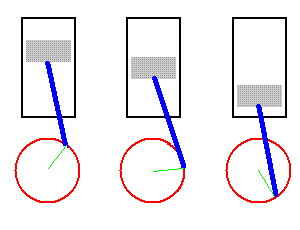
As the piston moves down the cylinder during the power
stroke, the force of the expanding gas is fed through the connecting rod
(shown in blue). This force provides the torque to the crankshaft to
make your engine turn. If you recall from an earlier unit, the torque is
force times lever arm (shown in green) but it also has to do with the angle
between these two quantities.. Torque is a maximum when the angle
between the applied force is 90 degrees to the lever arm. Any angle
smaller than that and you have to diminish the torque by sin
θ (where θ is the angle between line of force and
lever arm). Therefore, the torque delivered to the crankshaft is
significantly lower when the piston is at the top or bottom of its stroke.
The second reason the torque is not uniform deals with the applied force.
As the piston moves down the cylinder, the pressure of the gas drops so the
applied force delivered to the connecting rod is not constant throughout the
power stroke.
- What is a Wankel rotary engine? How is it different from the 4 stroke
engine described above? What are some advantages and disadvantages it
has over the 4 stroke engine.
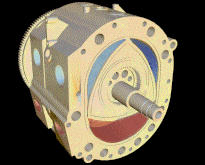
 animation
animation
The animation shows a cut away of a Wankel (rotary)
engine. Instead of a piston that moves up and down (as in the Otto
cycle), three chambers are formed by the rotor and engine block. As the
rotor spins, it changes the volume of the chamber in the same way the volume
changes in combustion chamber of a traditional engine. Each chamber goes
through cycles of compression, power stroke (after ignition), exhaust, and
intake.
Since the rotor
spins in one direction they can run at faster RPMs. In your car, the pistons
are constantly changing directions and that change in inertia is inefficient
and stressful on parts. This engine has fewer moving parts, but has slightly higher fuel consumption
over a traditional engine. In addition, rotary engines tend to put out
more pollutants as well. Rotary engines are found in Mazda sports cars.
-
What is a Jonova engine? How is it different from the
conventional Wankel rotary engine?
All rotary
engines have certain advantages over conventional engines (see last answer),
but this particular engine has an additional advantage over all other rotary
engine designs. What makes the Jonova engine appealing comes from the fact that the rotor moves in a
perfect circle. Students at the University of Arizona have designed a
Jonova engine with only 4 moving parts … an extremely simple design.
- Modern jets use an engine with a turbine (such as turbojet). Briefly
describe the principles involved to provide thrust (including the function of
the turbine and how the turbine is powered).
A turbine is
just a giant fan used to move air in one direction. In a turbojet, the
air is moved to a combustion chamber which is open at the front and the back.
Since the turbine insures that the air can only go IN the combustion chamber
from the front, it has to be exhausted out the back (at a very high speed).
This is the classic Newton 3rd law action-reaction that provides the forward
thrust for the aircraft. The turbine not only helps draw air into the
combustion chamber, it also compresses it for a more powerful burn when it is
mixed with the jet fuel. At the exhaust end, there is another turbine
that is forced to spin by the expelled gases and it is the power of that
blade that moves all the other parts.
- Describe how the Stirling Engine works. What are some practical
applications to this design?
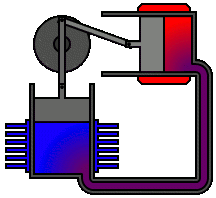 animation credit
Richard Wheeler
animation credit
Richard Wheeler
The Stirling Engine is another engine design which relies on the
performing of useful work from reservoirs at different temperatures (something all
engines do). Gases never leave the engine and there is no ignition of a
gas at all. How is this possible? There are two pistons ...
one in contact with something hot and the other is in contact with something
cold. The gas is moved from one piston to another. When the gas is
in contact with the hot reservoir it absorbs heat and expands ... pushing a piston down
and in the process, does useful
work. This action drops the pressure of the gas. The gas is then transferred to a cold piston where it is
compressed. This
raises the pressure of the gas but also forces heat out of the gas which flows
to the cold reservoir. The gas then goes back to the hot reservoir and
the cycle repeats. It runs very quietly and is used in submarines. The hot
source is a nuclear reactor and the cold source is the seawater.
Howstuffworks has a great article to fill in the gaps.
- One popular vehicle is the hybrid. It uses a gasoline engine
as well as an electric motor. Under what conditions is it designed
to use the electric motor? How do the batteries for the motor get
recharged? What other designs are typically incorporated to improve gas
mileage?
Hybrid cars reduce dependence on fossil fuel because the cars
sole dependence is not on gasoline. The hybrid car works with both a small
gasoline engine and an electric motor that has a set of batteries. While
driving the car, it switches from electric power to gasoline power. The
gasoline engine is mostly used for driving at constant speed and the electric
motor is
used for accelerations and climbing hills. A computer determines when the
gasoline engine is needed. The gas engine recharges the batteries when
it is running. The car also saves when
you come to a stop, for example at a stop light (the gas engine will completely shut off).
A hybrid car is capable of much greater energy efficiency
than one driven by an internal combustion engine. In the well-established
technique of "regenerative braking" the vehicle can recapture the
energy of motion that is now dissipated (and wasted) in wheel brakes, and feed
it back into the car batteries. The electric motors used to drive the wheels
function as
electric generators that take energy from the wheels and convert it back into
electric energy. Because these cars have such a small gasoline engine, they are
much lighter and, therefore, more efficient. In addition, the body style
is more aerodynamic than convention cars.
Alternate Fuels
Fuel from Coal -
Liquefaction of coal has been around since 1920 and Hitler made extensive use
of it for transportation in WWII. It may help relieve our
dependence on foreign oil (we have 150-200 years of coal reserves). To
make coal fuel, coal is heated with a hydrogen and a catalyst at high
temperatures. Another way is to first turn the coal into a gas and then
convert the gas to a liquid (Fischer-Tropsch
process). South Africa and China have made advances in mass production of
coal fuels. The US is now using coal gasification to generate electricity
(Barstow, California in the mid 1980's and
Polk Power Station near Mulberry, Florida is considered a model for future
development). The Polk power plant is one of the cleanest and has won
numerous
awards. However, it still puts out massive amounts of
carbon dioxide. One answer is to bury it (called carbon sequestering)
which may be done in a futuristic "Polk six" power plant. One of my
sources is
here.
__________________
Ready to toss out the conventional nuclear reactor (which uses radioactive
uranium as a fuel)? A thorium nuclear power has great potential as
a power source in the United States because there are estimates of enough here
to last at least a thousand years because it is a common radioactive material in
the crust of the earth. Producing electricity with this method has several
advantages over the conventional nuclear power. The biggest two are -
dramatically less radioactive waste products and no worry of a Chernobyl type
meltdown. Click
here to
read more.
__________________
One of the best working fuels I have seen to date is compressed air.
http://www.popularmechanics.com/automotive/new_cars/4217016.html
In that car it would only take $2 to fill the car with about 340 liters of
compressed air. A down side of the car is the limited speed it can achieve but I
would rather go a little slower and pay less.
_________________
Biodiesel
An alternative to petroleum is Biodiesel -- fuel made from vegetable oil sources
(and even animal fat). Some of the advantages are:
- Reduced engine wear.
- Neutral CO2 emission (because it takes about as much CO2
out of the atmosphere as it puts back).
- Renewable (made mostly from Soy and Grape Seed oils).
- Nontoxic (you can drink it but they say it tastes bad).
- Can be used in Diesel engines unaltered (no refining) and in home heating
(to replace oil burning furnaces)
- Can use the same infrastructure for delivery as petroleum.
What I really like is the BTU/gal is almost the same as regular diesel
(140,000 BTU/gal vs. 130,000 BTU/gal)
When you burn biodiesel you are still putting carbon dioxide into the air but
with a big difference. The carbon is not coming from buried sources
(fossil fuels). That is, you are putting the carbon on a short track in
the cycle. Farmers are removing CO2 from the atmosphere when the source
plant is grown and it goes back into the atmosphere via the tailpipe (and during
production). This does not consider the emissions from the fossil fuels
used in the production of the crop (which can be significant).
One big problem deals with the amount of farmland required for large scale
production. Where are we going to grow the crop? Is this going to
replace land used to grow our food? Some have suggested we grow algae in
marine environments to produce Biodiesel.
http://www.ag.ndsu.edu/pubs/ageng/machine/ae1240w.htm
E85
E85 is a mixture of up to 85% ethanol and gasoline (a fossil fuel). It is
being used very successfully just over the border in Minnesota. It is also
working for Brazil which uses sugar cane to produce Ethanol. Cars that can
use E85 are labeled "flex fuel" cars. These same cars can run on
ordinary gasoline as well. That is to say, you cannot put E85 in just any
car but one that has been engineered to accept this fuel.
Ethanol is cheaper than gasoline but also has a significantly lower
energy content (81,800 BTU/gal
vs. 114,000 BTU/gal for gasoline) ... plus the controversial
issue of energy required to produce the stuff.
Studies have shown that
ethanol supplies "slightly" more energy than is used in its production (which is
still based on fossil fuels). So by using E85, your car will be 25-40%
less efficient and you are not really solving any issues with fossil fuel
reduction as long as we use petroleum in the production of E85.
Another problem with producing E85 in the U.S. is that
corn is being used to manufacture it. Why is that bad? It puts pressure on
the food supply because corn is used as cattle feed and is a staple in our diet. It also cannot be
shipped in the same pipelines that now carry gasoline because it is too much of
a solvent (that's why it degrades plastic and rubber) and because it contains
too much water.
The next question is whether E85 reduces carbon dioxide emissions? It
may seem that E85 is carbon neutral because the CO2 emissions it exhausts to the
atmosphere during combustion are offset by the atmospheric carbon intake when
the crop is growing. However, this does not take into account several
factors such as the fossils fuels consumed in the growing and processing of E85.
The jury is still out as to just how much CO2 E85 emits (vs gasoline) but it is
far from carbon neutral. The good news is the numbers
improve when you consider cellulosic
ethanol (made from plant fibers). Producing ethanol from
switchgrass seems like a logical choice. The stuff grows in places
that would not compete with agricultural food production and the greenhouse
emissions would be significantly reduced.
Petroleum from bacteria?
Genetic engineering may be the technological "fix" to our energy problems.
Companies like LS9 are finding
ways to convert bio products directly into petroleum by making bugs (microbes) that do the
conversion as part of their metabolism. Wow! This could be big!
Imagine a day when your take your grass clippings in to a recycling center and
exchange it for a tank full of gas. This would certainly be carbon
neutral, not compete with food crops, and cut our dependence on foreign oil.
Refrigerators
- How much can an average family expect to pay per year to run a typical
refrigerator?
According to the focus-on-energy web site, you can
save $143 each year by trading in your 10 year old refrigerator for an new
energy efficient model.
Here is their breakdown:
Annual cost to run a new Energy Star refrigerator (at current rates in
Wisconsin) = $50
Annual cost to run a typical 10 year old refrigerator = $193
Savings = $143
- Describe the energy efficiency ratings for refrigerators and air
conditioners. Define all terms. What numbers are considered the best?
When you shop for an appliance, you will most likely see
an Energy Star label on the front of the appliance. This label is the
government's seal of approval, created to set the criteria to help shoppers
identify the most energy-efficient products on the market. There are federal
efficiency standards and to qualify as an Energy Star appliance, it needs to
exceed the existing federal efficiency standards, which most fall in the 13 to
20 percent higher than the standard. Having met this standard means you are
buying a high-performance product which will reduce the operating cost of that
appliance or product every month during the course of its lifetime.
Air conditioner efficiencies are rated by a SEER
(Seasonal Energy-Efficiency Rating) value. This value represents a ratio
of two quantities: BTU's of cooling / electric energy used (in watt-hours) to
run the compressor.
The higher the number, the more efficient the unit. Older units have
SEER ratings <10, but newer units have ratings of 13 and higher. The
highest I've found was 19.5
Let's assume you have an air conditioner with a SEER rating of 14. To
make a proper comparison, we can
convert 14 BTU to 4.1
watt hours. This means this unit will produce 4.1 units of cooling for
every unit of energy it takes to run the device. You might ask, "How is
that possible? This sounds like you are violating the first law of
thermodynamics!!!" No ... an air conditioner is a "heat mover". It
is taking energy from the room and moves it to the outside. So, in fact,
you are using 1 unit of electrical energy to move 4.1 units of
heat energy.
Other "heat movers" have a similar efficiency rating called EER or COP.
Don't worry about the definitions, but they all strive for a higher number.
For refrigerators, it will state how much
electricity it will use in one year. The smaller the number, the less energy
it uses. New models tend to use 20% less energy than required by the
standard- and 40% less energy than one sold 7 years ago!
So for refrigerators, look for the lower number. On
air conditioners, look for the higher number.
If you are planning to shop for an appliance, check
this website out to do an excel spreadsheet with analysis on your savings:
http://www.doityourself.com/stry/energyratings
- Is it a good idea to leave your refrigerator door open on hot days to cool
the room down? Explain.
This would only work for Dumb and Dumber! Even if
the compressor unit took no energy at all to run, all you would do is break even.
The heat released by the condensing coils would equal the heat absorbed by the
evaporator. However, it does take energy to move this heat (you use
electricity to run a compressor) ... which makes heat. So, in fact, you
would be heating the room by running the frig with the door open.
- Explain the environmental problems caused by using chlorofluorocarbons
(CFC's) as refrigerants. When were they banned?
When CFC's are released to the atmosphere, they get
swept by wind currents and find themselves in the stratosphere. There,
UV radiation breaks these long molecules down to their constituent parts - one
being chlorine. Chlorine breaks down ozone (our atmospheric UV filter)
but the worse part, it reacts in such a way that it remains in the the
atmosphere to destroy more ozone. This effect was discovered in the
early 1970's and the US took action in 1978. The international ban,
called the Montreal Protocol, was signed in 1987 (and enforced the
next year) which banned CFC's like Freon as refrigerants. However, a
student reported from
here: By the end of 1995, EPA banned most production and
import of R-12 (a CFC). However, the use of R-12 is still permitted until
supplies are depleted. Only certified professional technicians can get
their hands on CFC's.
- What is a geothermal heat
pump? Why is this option a better choice for Wisconsin (verses a traditional
heat pump)?
In a traditional heat pump, you use outside air as the
heat source (for winter heating). A geothermal heat pump uses heat in
the ground as the source (coils are buried underground or in a body of water).
In Wisconsin, the winter air is considerably lower than the ground so you have
to move the heat over a greater temperature difference. This lowers the
efficiency to the point that heat pumps do not work well in Wisconsin.
However, the ground temperature remains relatively constant throughout the
year. If you can withstand the much higher initial costs of installing
this system, it becomes a reasonable option here.
- A refrigerator is a device designed to "move" heat energy. In this case,
you are trying to push heat "uphill", ... that is, from a lower temperature
reservoir to a higher temperature reservoir. Is this a violation of the
second law of thermodynamics?
Let me start by examining something I witnessed as a
young student. The device was a "hydraulic ram" pump. In this
device, it was possible to move water above its source ... making water run
uphill!!! I was amazed and felt something was terribly wrong as if I've
been tricked. It was no trick. Water did indeed move uphill but in
a way, it was done with a bit of "smoke and mirrors". The secret to this
device is realizing that a lot of water needs to be moving
downhill to make a little bit of water move uphill. When
trying to answer the question, it is best to look at this example as a guide
when we ask - does a refrigerator violate the second law of thermodynamics?
No way! By now you should know that the natural
tendency is for heat to move from hot to cold. A refrigerator moves heat
the other way so you might think that entropy is decreasing (you are gaining
order). However, this does not happen all by itself. Energy
needs to be put into the system to run the compressor. This is in the
form of some very "high grade" energy with lots of "order"
- electricity! What does all this "high grade ... high entropy"
electrical energy do? It moves a little bit of heat "uphill". This
represents a loss of entropy (or a gain in order) ... sure, but it only works
if you gain even more entropy (in this case, the dissipation of high ordered
electricity). If you take that into account, the
overall entropy of the system is still increasing. The second law is
not violated!
- What is a magnetic refrigerator? How does it work and
where is it applied?
It all comes down to a magnetic effect (rather than a phase change
effect). When certain substances (like gadolinium)
are exposed to a magnetic field, they respond by releasing heat. It
also absorbs heat when the magnetic field is turned off. The trick is
to place this substance on a wheel that passes by permanent magnets. When
the gadolinium passes by a magnet, it gives off heat and this heat is carried away by water
... which is released to the room. When the gadolinium moves away from the
permanent magnet, it absorbs heat, which it takes from water (in another loop) .... cooling
the water down. This
water then circulates around your food. If interested, read
this. Denmark is working on a
prototype that may someday become the standard method of refrigeration.
Cool!
Care to get more technical?
Let me have a shot at this one. Carefully stretch a rubber band and
place it to your upper lip (an area very sensitive to heat). Now let the
rubber band relax (while still in contact with your lip). You feel a
cooling sensation! Why? It has to do with the way the molecules in
the polymer are arranged. In the relaxed position the molecules are all
tangled up and twisted together. The molecules in this position have a lot
of opportunity for motion. However, when the rubber band is stretched,
there is less opportunity for motion as the long polymer molecules are forced
out of position and into straight lines. Now we let the rubber band
suddenly move to the relaxed position. The molecules in the polymer now
have many more opportunities for motion (as they reform into a tangled state).
Internally, the energy now "spreads out" to fill the (now) available modes of
motion. Since there is now more opportunity for motion, the polymer
molecules rob some energy from your lip to fill in the voids. It soon comes
to equilibrium. I've seen this demonstration described in terms of entropy
but the details can make your head spin. You can apply the same logic to
the magnetic refrigerator. When the magnetic field is removed, the
substance is suddenly offered many more internal ways to handle energy.
Therefore, its internal energy "spreads out" to these new niches and absorbs
energy from the outside to reach an equilibrium.
Now for a neat "twist" to this whole discussion of polymers. If you
heat a polymer it will do something crazy ... it shrinks (ever hear of
Shrinkwrap?)! Adding heat to the polymer is the same as letting it absorb
heat from your lip. The polymer molecules respond by becoming even more tangled
and twisted as it gains more opportunity for molecular motion ... and it
shrinks!
- The ideas presented in this unit are responsible for the greatest mass
migration of people in human history. Explain!
One could argue that the automobile allowed us to become
mobile but you first have to have a reason to move. That came when home
air conditioning became affordable. In 1951, Carrier introduced a home
unit that caused a mass movement of people to warmer southern states.
Within 10 years cities like Phoenix, Tampa, Dallas, Houston and Atlanta
exploded on the map.
Cooling by Evaporation
The surface area of a dogs tongue provides an area to cool through
evaporation. Dogs stick their
tongues out when they pant. This is a way
to regulate their body temperature. The saliva turns to water vapor and cools
their body, along with blood flow in their tongues.
Before even iceboxes, tribal people used
clay pots made of earth to cool
their drinking water supply. The pots were naturally porous so as water escaped
and evaporated, it helped to cool the pot and thus the remaining water still
inside the vessel.
One alternative way to cool a building is to use evaporative cooling towers
(usually on the top of a building). Basically water flows in pads and some
evaporates leaving the remaining water significantly cooler than the surrounding
air. This water can be used to cool the interior of the building.
This works best in areas where the outside air is hot and dry.
This page has a nice animation.
Have you ever seen a mist cooling system? When the mist evaporates it
can make the surrounding air 30 degrees cooler. This is often seen on TV
during football games played in early part of the season.
You can have a cool drink of water when biking with the
maxchill bottle.
Water in a sponge jacket evaporates and cools the water inside.
They recently came out with a new
cooling vest for biking. It retains water then lets it out as a gas that
cools you off.
One device that uses evaporation to remove heat (via evaporation) is a
heat pipe. A working fluid (refrigerant) with a low boiling point is
confined to a sealed container. Heat is extracted from the outside of the
pipe to vaporize the refrigerant. The vapor moves to an area of
condensation (where heat is released to the outside). Finally, the liquid
is returned to the evaporator using a wick (which uses the principles of
capillary action). The system requires no external power source and
can be highly efficient in removing excess heat from an area. Heat pipes
are used to transfer heat in spacecraft and even in laptop computers. Read
more here.
My pool has a solar blanket. As the name implies, it is designed to
trap solar energy and heat the water during the daytime. However, its
bigger effect is to prevent evaporation. Without this covering, heat
would be escaping from my pool via evaporation when I'm not using it.
Evaporative cooling is used in cooling a small fermenter to make wine.
In order to make wine it has to be fermented in a set temperature environment of
about 60 F. If a evaporating surface surrounds your fermenter, evaporation
literally sucks energy, in the form of heat, out of the fermenter. This causing
cooling under most, but not all, environmental conditions.
Source
Airplanes
Helicopter question - What is the function of the tail rotor?
The tail rotor of a helicopter provides a counter torque produced by the main
blade. If not for a tail rotor, the helicopter would simply spin in the
opposite direction of the main blade (action - reaction). It is also used
for control motion about a vertical axis which aviators call yaw.
Applications of Bernoulli
There are several great posts that demonstrate Bernoulli at work but my
favorite was the Bernoulli Grip
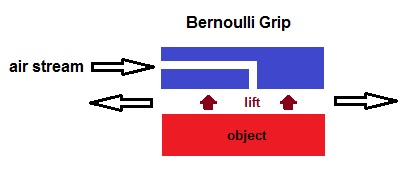
This device is used to lift delicate electronics (circuit boards, chips,
photovoltaic cells, etc) during the manufacturing process. It eliminates
contamination because there is no physical contact between the grip and the
object being transported.
Great Aviators (brief answer)
-
Amelia Earhart
- 1932 - First woman's transatlantic solo. In 1937, she attempted with
Frederick J. Noonan to fly around the world, but her plane was lost.
-
Capt. James
Gallagher - 1949 - First round-the-world nonstop flight.
-
Charles Augustus
Lindbergh - 1927 - First solo nonstop transatlantic flight.
-
Charles E.
Yeager - 1947 - First piloted supersonic flight in an airplane.
-
Dick Rutan and
Jeana Yeager - 1986 - First nonstop flight around the world without
refueling.
-
Steve Fossett
- 2005 - First nonstop solo flight around the world without refueling and (2002)
first solo nonstop round-the-world balloon flight.
-
Yuri Gagarin
- 1961 - The first human in space (USSR)
-
Neil Armstrong
- 1969 - First man on the moon (first of 12 to walk the moon)
Incandescent Lights
- Explain why solids which gradually heat up will become incandescent in the
color red first.
This is actually a pretty tough question. The
easiest way to answer it is to study the Blackbody radiation curves seen in
the eBook.
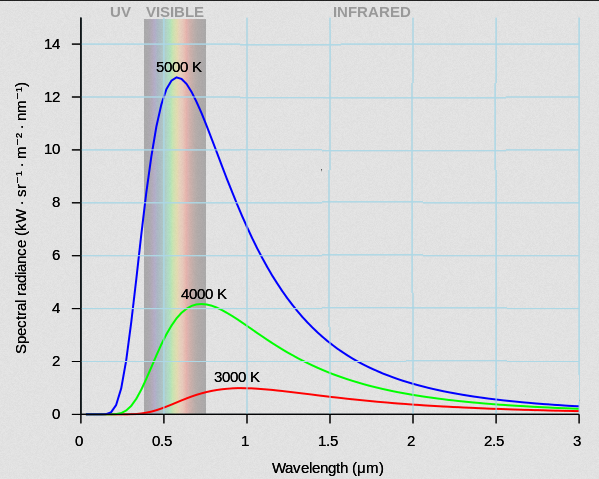
Courtesy
Wikimedia Commons
You can see that cooler object at 3000 K is putting out
most of its energy in the infrared but there is still some energy emitted in
the visible. But what kind? Most is towards the red side of the
visible spectrum and almost none in the blue side. Our eyes would see
that as being a red object. By the time the object is heated to 5000 K,
it is producing energy in all parts of the visible so it might look white hot
to our eyes. If you want to get super technical? Read on if you
like.
When you heat a solid up, the molecules vibrate faster and faster. This is associated with energy. The frequency
of vibration is associated with the type of electromagnetic radiation it is
capable of emitting. There is a famous equation in physics: E = hf which says that
the energy of a photon is related to the frequency of the wave (which I hinted
at when covering photovoltaics in unit 4 when I wrote E
~ 1/wavelength). That frequency
matches up with the frequency of the molecular vibrations. When you get
a large number of molecules moving (a heated solid), some will be moving
faster than the average, some slower. The combined result is the
radiation curves you see in the class material. It gets pretty
complicated because quantum effects also come into play (which we will not
bring up). The reason you first see red comes from the fact that red
light is the lowest frequency in the visible spectrum. You should
understand that when you observe something "red hot", only a small percent of
the molecules are vibrating at that frequency. Most of the molecules will be
vibrating with a frequency corresponding to radiation in the
infrared. The next question may help you see what happens when the solid
continues to get hotter.
- Explain why planets orbiting a blue star would probably not be habitable.
This question is a follow-up of the last question.
As a solid continues to heat, the radiation curve undergoes two changes.
First, it gets bigger (at all frequencies) and second, the peak shifts to
higher frequencies (shorter wavelengths). There are radiation curves in the
diagram above. The one marked 3000 K is a red star (where most of the
energy is really in the infrared). The reason it appears red comes from
the observation that it emits much more red light than blue light in the
visible. The 5000 K curve is more like the radiation curve of the
sun (which peaks in the visible). Now imagine (by following the trends)
the radiation curve of a star radiating at 20,000 K. It
will put out much more blue light than red and appears blue in color to the
eye. However, most of the radiation will be in the ultraviolet. UV
radiation is damaging to organic molecules which is why you wear sun block and
UV protection in sunglasses. Note: Stars are not solids but
compressed gas ... which behave the same in terms of radiation.
Another student pointed out a phenomena known as the "photoevaporation
effect". This says the high energy UV radiation coming from the
star is capable of heating the atmosphere to the point it evaporates
into space. It is hard to live without an atmosphere. This effect
could even be strong enough to prevent planets forming in the first place.
Another clever answer has more to do with the physics of stars. Blue
stars are high mass stars with a much shorter lifespan. If life could
develop quickly on a planet orbiting a blue star it would most likely be very
primitive. Assuming it takes a long time to develop higher orders of
life (intelligence), the blue star is an unlikely place to find it.
Finally, another student found an
article that explains that the "photoevaporation effect" can even create
danger zones to other nearby stars within 1.6 light years.
Danger!
Will Robinson Danger!
- Often times you may notice a black or grayish film deposited on the inside
of an incandescent light bulb that no longer works. What causes that (where
does it come from)?
The gray film comes from tungsten vapor that condenses
on the cooler glass on the inside of the bulb. The vapor comes from
tungsten atoms that sublimate (evaporates) off the solid filament. This
weakens the filament but also increases the electrical resistance. This,
in turn, makes the filament hotter (per unit area) which accelerates the sublimation.
This is how most light bulbs die.
- How is a halogen light bulb different from an ordinary incandescent light
bulb? What are some advantages of halogen light bulbs?
Halogen lights are still less efficient than vapor
lights ... but they are at least more efficient than an ordinary incandescent
light bulb. A halogen bulb refers to the gas within the bulb ... not the
filament itself. These bulbs still have a filament, but it is able to
burn much hotter ... shifting more of the energy emitted into the visible
portion of the spectrum (more like the radiation curve of the sun). In
addition, the filament lasts much longer because it is able to recycle
evaporated tungsten atoms back onto the filament.
Tough Questions (these are not on the test ... so read for interest)
- Calculate the wavelength your body radiates the most in? What part of the
EM spectrum is this? Show all work.
λ(max) = 28,900,000/T (Wien's Law) The
human body is 98.6 degrees Fahrenheit which
converts to 310 K.
λ(max) = 28,900,000/310 = 93,225 Ǻ = .0093 mm
(for comparison, red light is .0007 mm). This is in the far infrared.
- Compare the energy output of 3 different stars - a red star, a blue star,
and our sun. First assume they are all the same size, then recalculate
assuming each star is a typical main sequence star. For bonus points include
a red giant and red super-giant in the comparison. Normalize all your answers
on a scale where the total energy output of the sun =1. Don't worry, I would
never think of asking this on an evaluation. (Can you tell I taught and love
astronomy?)
The Stefan-Boltzmann Law says E
~ T4 Let's use these values for
T: red star = 3000 K sun = 6000 K
blue star = 25,000 K
3000^4 = 8.1 E 13 6000^4 = 1.3 E 15
25,000^4 = 3.9 E 17 If we make sun = 1, then red star = 6% * sun
and blue star = 300 * sun (this assumes the stars all have the same size
because the equation tells us energy emitted per unit area)
Red giants are about 100 time the size of the sun and super giants are 1,000
time the size of the sun. Surface area of a sphere is S = 4πR2
so a red giant has 4*π*1002 = 126,000 times the surface area of the
sun so it puts out about 7,500 times the light of our sun (126,000 * 6%)
a red super giant has a surface area 4*π*10002 = 12,600,000 time
the sun so it puts out 750,000 time the light of our sun.
Now think back at the light bulb question I asked in the eBook. If you
recall, the question was which light bulb was brighter when comparing two
bulbs whose filaments were of different thickness. The answer was the
bulb with the thicker filament was brighter. The answer for the stars is
a similar situation. The thicker filament offers less resistance and
draws more current but it is also cooler. But wait, wouldn't a cooler
filament be dimmer? The eBook even says "hotter is brighter" !!!
Yes, per unit area. So the thicker filament will actually be cooler and
produce less light per unit area but there is considerably more total area
(like the red giant or red super giant stars). Therefore, the total
light output of the thicker filament will still be more than the bulb with the
thinner filament. Another factor here is lifespan of the filament.
A cooler filament will last much longer than a hotter filament. The down
side is that the blackbody curve tells us that cooler also puts out more
energy in the infrared. This is wasted energy. No matter how you
cut it, incandescent bulbs are inherently inefficient.
Light bulb History
Did you think Edison really made the first light bulb? Think again! In 1835 James Bowman Lindsay demonstrated a constant electric light at a
public meeting in Dundee, Scotland. He stated that he could "read a book at a
distance of one and a half feet". However, having perfected the device to his
own satisfaction, he turned to the problem of wireless telegraphy and did not
develop the electric light any further. His claims are not well documented.
http://en.wikipedia.org/wiki/James_Bowman_Lindsay
_________________
Joseph Swan, a British
inventor, obtained the first patent for the same light bulb in Britain one year
prior to Edison's patent date. Just ask any Brit who invented the light bulb and
you will get a different point of view.
http://www.coolquiz.com/trivia/explain/docs/edison.asp
The other thing you should be aware of is that the incandescent light bulb is
soon to go the way of the doo-doo. The phase out of these energy wasters
is already underway on the international scene and will soon be seen in the US.
I hesitate to put in exact dates because legislation can change things on a dime
but it is coming, none-the-less.
Vapor Lamps
- Compact fluorescent lamp (CFL) bulbs are the kind you screw into a socket
designed for an incandescent bulb and are readily available. What are the economic
advantages of switching to this style of bulb over incandescent bulbs of the
same light output? Give specific numbers.
For the sake of comparison, let's choose a 100 watt
incandescent light bulb as the standard. This bulb has an expected life
of 8,000 hours and costs $.25 (local store) .
A 23 W compact fluorescent bulb that has the same light output.
This bulb has an expected life of 10,000 hours and costs $2.25 (However,
I paid $.99 on sale plus Focus on Energy rebate)
To make an equal comparison, we can consider 40,000 hours of lighting with
each style (this is the lowest common multiple of 8000 and10000).
This yields:
| Bulb |
100W incandescent |
23 W compact fluorescent |
| # of bulbs needed for 40,000 hours |
5 |
4 |
| cost of bulbs |
$1.25 |
$9.00 |
| energy used (in 40,000 hrs) |
4,000 kWh |
920 kWh |
| cost of electricity (@ $ .13 per kWh* |
$520 |
$120 |
| total costs (bulb + electricity) |
$521 |
$129 |
* WE - Energies rate in 2016
The winner is compact fluorescent bulbs by a long
shot.
- How much can carbon dioxide emissions be reduced (in any given time
period) by switching to compact fluorescence bulbs?
First you have to remember that we get most of our
electricity by burning coal and coal puts out lots of greenhouse gas (CO2) to
the atmosphere. According to
this government site:
On average, 1.3 pounds of carbon dioxide are emitted to the atmosphere for
every kWh of electricity produced. If we use the example in the last
question, a 23 W compact fluorescent bulb puts out the same light as a 100
watt incandescent bulb. This saves 77 watts of electricity. Over
the 40,000 hours of use (which was used in the last problem), this would save
3,080 kWh of electricity. This equals 4004 pounds of carbon dioxide
emitted to the air .... 2 tons! Please .. to save money and our planet
... replace your wasteful incandescent bulbs with compact florescent bulbs.
- What are some environment issues with the use of compact fluorescent bulbs
either in the manufacturing process or disposal phase?
The main problem deals with mercury and lead (both
harmful in the environment). In addition, there may be PCBs
(polychlorinated biphenyls - a known carcinogen)
in the ballast of very old fixtures (prior to
1979). Don't panic - one broken bulb is not the end of the world but in
volume, the amount of toxins can add up. How should you dispose of used
fluorescent bulbs? In Wisconsin, please contact a site on
this page.
One type of compact fluorescent bulb is known as a CCFL (cold cathode
fluorescent lamp). These are usually used in notebook computers as
the backlight source. However, they are now available for household
lighting. They use
85% less mercury than conventional CFL lights. As a bonus, they are
dimmable
- Why do some florescent lights start up poorly in cold weather?
All vapor lamps require a "kick start" when turned on to
get the mercury vapor ionized (so it provides a conducting path).
During cold weather, most of the mercury remains as a liquid (which produces no
light). As a result, a common fluorescent lamp will be dim, flicker in
cold weather, take several minutes to reach full intensity, or not start at
all. There are tricks to compensate for this deficiency. One
trick is to purchase lamps with a "cold weather"
ballast which provides a higher
start-up voltage to quickly force mercury to the vapor
state. Another solution is to supply the bulb with a constant "trickle"
current which keeps the mercury in the vapor phase ... even when the lamp is
not in use. This "instant -on" vapor lamp is wasteful.
- Compact fluorescent lamp (CFL) bulbs are the kind you screw into a socket
designed for an incandescent bulb. They do not use magnetic ballasts as described in the
class material but rather, electronic ballasts. How
does this work to limit current in the lamp? What problem does the electronic
ballast help solve (which you may experience when using a magnetic ballast)?
The standard AC line current is rectified to DC current
and then back to AC using solid state components (capacitors, switching
transistors, etc). An electronic ballast operates at a much higher
frequency (about 20,000 Hz) than ordinary line current (60 Hz).
Essentially the high frequency limits the current because there is very little
time (in any given half cycle) to grow to dangerous levels (like telling a
track sprinter he/she has to reverse direction every 10 feet).
This eliminates any flickering (and audible hum) you could possibly notice
with standard vapor lamps. The electronic ballast also allows some
fluorescent lamps to work with dimmer switches.
- Are compact fluorescent lamp (CFL) bulbs dimmable? Are 3-way (with multiple light
settings) CFL bulbs available? If so, compare the initial cost to a typical CFL
bulb.
CFL lamps are now found in dimmable and 3-way varieties
but it will cost you. Let's compare three bulbs with a rating of
approximately 14 W using 2017 data (Amazon Prime cost per bulb):
Regular CFL bulb: about $3.25
Dimmable CFL bulb: about 3.90
3 way CFL bulb: about $8.99 (16,
25, 32 W)
Warning: Never put a standard non-dimmable CFL bulb in a dimmer switch
designed incandescent bulbs. It is a fire hazard!
Polarized Light (and LED's)
- Why is sky light 90 degrees from the sun so highly polarized? In your
answer explain why the sky appears blue.
There is phenomena known as (Rayleigh) scattering that occurs in
the atmosphere. Scattering is a re-direction (mostly at right angles) of
a light beam when it encounters a molecule and the effect gets stronger the
closer the wavelength of the radiation matches the size of the molecule.
As a result, the nitrogen and
oxygen molecules in our atmosphere scatter blue light more effectively than
red light. As a result, the sky appears
blue and the sun sets with
the color red (because that color is not scattered as much). As a result of scattering, the light becomes
polarized. The way to observe this is to use a pair of polarized
sunglasses on a sunny day and look at the sky 90 degrees from the sun.
You may have to rotate your head a bit to see the change in light intensity.
Several insects (bees) can detect polarized light and use this as a
navigational tool.
- Many astronomers have a polarizing filter in their equipment bag. What
purpose does this filter server for a back yard observer?
Even with a moderately sized telescope, the moon can be
blinding. A polarized filter is actually two polarizing filters which
are free to rotate with respect to each other. As a result, you can
alter the light intensity to a comfortable level. These same filters may
be used to change the intensity of binary stars where one star is much brighter
than the other and the glare of one star obscures the dimmer one.
- One way to produce 3D effects in the entertainment industry is to use
polarized light. The user wears a pair of glasses and watches an image
projected on a screen. Explain how a 3D effect is accomplished here.
The scenes are shot with two cameras spaced apart from
each other (to simulate the depth perception achieved by two eyes).
Images from each
camera are projected on a screen with a polarizing filter on it but oriented at 90 degrees with respect
to the other camera. The
audience wears a pair of glasses which are really just polarizing filters.
As you might guess, the filter over one eye is rotated 90 degrees with respect
to the filter in the other eye. This way, each eye perceives the image
from a different camera. (Note: if you have one of these 3D glasses, use
it to verify the polarizing effect in the sky as stated in the first question)
- Another way to simulate 3D effects uses more expensive "shutter glasses".
Explain how that works.
This technique requires precise timing between the glasses and the refresh
rate of the screen. For one short interval an LED in the glasses becomes
transparent and displays the screen in one eye and blocks the screen in the
other eye. During this same time, the screen projects a view from one
perspective. Then the view shifts to the other eye and at the same time
the screen projects a view from a different perspective. The shutter
rate is so fast you are unaware of the transition and you see the screen in 3D
perspective.
- A related technology is known as OLED (where "O" stands for organic).
Here organic or polymer layers are used to merge "holes" with electrons to
produce light. What are some advantages to this twist over conventional
LED technology (or LCD - liquid crystal displays)? Please list 3.
OLED's are here to stay. They are thinner,
lighter, brighter, and more flexible than conventional LED's. In
addition, they offer a much wider viewing angle (about 170 degrees). OLED's have a better contrast ratio (difference between the blackest black and
whitest white) than LED's. In addition, an OLED has a faster response
time .... meaning it can change states quicker. This eliminates a faint
blur often seen in LED screens when viewing things that move fast.
OLED's consume less power than LCD (liquid crystal displays) because they
produce their own light. In contrast, a conventional LCD need to have a
separate light source in the background to produce the image.
- As a follow-up to the last question, list 3 disadvantages OLED's have over
the competition.
So far, the blue OLED has a shorter lifetime than the
red or green OLED's. You need all three to produce all the colors you
need. OLED's are also easily susceptible to water damage. Finally,
they are still more expensive (despite the fact they are easier to
manufacture) vs. conventional LED's.
- List 3 places OLED's are commonly seen today.
OLED's are commonly found in cell phones, digital
cameras, and GPS units (basically anywhere a small bright screen is needed).
They are still not the "norm" in flat screen TV's but OLED TVs are on the
market
now. And when they get cheaper, and fix some technical glitches ...
you'll love it.
Applications of Polarized Light
Farmers can use polarized light to see small changes in the leaves of some
crops. In doing so they are able to prevent spread of disease and malnutrition
of the crops.
http://www.sciencedaily.com/releases/2005/07/050727060608.htm
Astronomers recently made a discovery about our early universe using
polarized light. A study of the cosmic background radiation show degrees
of polarization that supports a model known as "inflation".
Inflation claims that just after the Big Bang, our universe underwent a very
brief spurt of exponential expansion when it doubled in size (at least 80 times)
every 10-37 second. This discovery offers the first
observational evidence that this rapid expansion actually did occur.
Oddly enough, certain insects (bee and ants) as well as octopuses are able to
detect polarized light. How is this helpful? Insects use it for
navigation and only in the ultraviolet because this type of light is able to
penetrate clouds. This way they can navigate even on a cloudy day.
The octopus (and cuttlefish - a relative of the squid), have the ability to
change the state of polarization of their skin. Perhaps they use it for
communication. Their polarization vision also allows them to detect
contrast in transparent prey like plankton and jellyfish. All from
this
page. Another student found that
bats also use polarized light to navigate.
Optics
- White light disperses into the full spectrum when it passes through a
prism. Explain why this happens.

The separation of light into its component colors when
passing through a prism is called dispersion. As you already
know, light refracts (bends) when entering a medium because it changes speed.
Blue light refracts more than red light because it moves slightly slower than
red light (in a non-vacuum). Note: If you want to take this
discussion further, the individual photons move at "c" between the
atoms of the medium but are absorbed and re-emitted by the atoms themselves.
This takes time which reduced the average speed to something lower than c (the
speed of light in a vacuum).
- If you were trying to spear a fish, should you throw the spear where you
see the fish or some other direction? Explain.
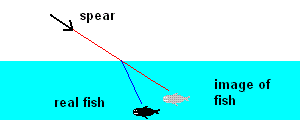
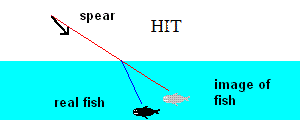
The light rays are refracted when they meet the
air/water boundary. If you toss the spear where you see it (image of fish),
you will go hungry. The actual fish is closer to you. You will
need to aim lower to actually spear the fish.
- A hologram looks like a 3D projection in space. However, this page refers
to it as a virtual image! Is this an error? Explain.
No error! Each eye observes a virtual image from a
different perspective to give the illusion of depth perception. This
makes the hologram appear as a real image in much the same way a
View Master™ works.
- What does the f-stop refer to in cameras? How is the scale calibrated?
That is, what is the significance to the numbering system? Which value gives
the largest depth of field? Which one required the longest exposure times?
The f-stop is a way of telling how much light is getting
through your camera lens. It is a ratio of the focal length of the lens
divided by the diameter of the lens. The focal length of the lens does
not change but you can easily adjust the aperture (in the same way your iris
controls the diameter of the pupil). The scale may seem a bit
strange - setting are: 1, 1.4, 2, 2.8, 4, 5.6, 8, 11, 16, 22, 32 and 45.
Each f stop lets in half as much light as the previous setting and twice as
much light as the next smaller setting. That is, as you move from f/2
to f/2.8, you decrease the diameter so it allows only half as much light in.
This will require a longer exposure time but also increases your depth of
field (so more of your subjects will remain in focus).
- Some large telescopes are using a technique called "adaptive optics".
What is this technique, and why is it needed?
You wear glasses or contact lenses to correct some
defect in your eyes. Surface based telescopes have to worry about
defects in the turbulent atmosphere. If the atmosphere didn't change at
all, you could simply put a correcting lens over the telescope to correct for
atmospheric distortions. However, the atmosphere is constantly changing
so you would need to constantly monitor and correct for atmospheric
distortions on the fly. This sounds impossible but that is exactly what
the best telescopes are capable of doing now. In fact, the resolution of
these systems surpasses the clarity of the Hubble Space Telescope. A
flexible mirror is molded into different shapes by actuators in the back
several time per second - amazing!
- Several of the ideas presented here can be applied in solar heating
systems for generating electricity or hot water. Give a specific example
where this has already been used.
One idea to use solar energy is being tried in the
Arizona desert. A
parabolic trough tracks
the sun and focuses sun light to heat mineral oil flowing in tubes located at
the focal point. The heat is transferred to water to make steam (which
turns a turbine). For more information, click
here.
- When light reflects off a flat mirror, it does so in a very predictable
direction. What is this "rule" for reflected light? Please attach a picture
to illustrate the rule.
The law is: the angle of incidence = angle of
reflection. See the animation below.
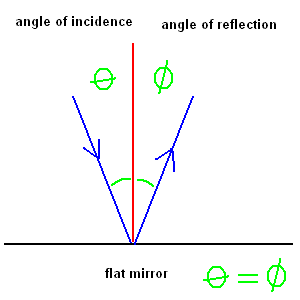 animation
animation
-
Harry Potter had a cloak of invisibility. However,
scientists have now accomplished the same thing (on a much smaller scale) in
reality. In fact, work is in progress on “sound cloaks” and even “earthquake
cloaks”. How is that accomplished? In your answer explain using principles
presented in this section.
The key to any cloak is to surround the object by
materials that have the ability to refract (bend) incoming waves (light,
sound, or even seismic waves) around an object much like the way you see water
move around a rock in a stream. This way the object is not affected by the
incoming wave and is essentially undetectable from an outside observer.
Please read
this link to learn more.
Besides lower construction cost, the use of mirrors over lenses in telescopes
has several additional advantages. Name one.
One disadvantage of a lens deals with the number of
precision surfaces you need to engineer. A mirror only needs to be precision cut
on one surface and a lens needs to have (at least) two precision surfaces.
This requires more time and money to accomplish. In a lens, the quality of
glass must be high grade since light has to pass through it. A mirror can
be made from a much lower quality glass since light never passes through it.
Now that you understand dispersion (see the prism
above), you may see that you would get the same effect in a lens.
That is, blue light has a shorter focal length than red light. To correct
for this problem, known as chromatic aberration, you can use compound lenses in
a carefully engineered arrangement so that all colors will focus to the same
point. As you might guess, this is exactly what is done in cameras
and binoculars. This adds to the overall cost and also increases the
weight significantly. Mirrors do not suffer from this effect.
The stability of a telescope is essential. One of the most overlooked
features is the mount the telescope sits on. The more weight in the
telescope, the more support required to stabilize it. Overall, mirrors are
much lighter than lenses. Therefore, mirrors offer a better choice over a
lens in this respect.
How are some of the very large professional telescopes mirrors designed? The
VLT and Keck telescopes are a few examples. There are even some very innovative
ideas that are quite unconventional. Please expand on one.
The use of "adaptive optics" is covered above.
This required thin, light weight, flexible mirrors that can change their shape
to compensate for atmospheric distortions. Most larger telescopes use
several smaller mirrors instead of one large mirror. Each individual
mirror will focus its light to the same point as all the other mirrors.
This cuts down on weight as well. A good example of this is seen in the
Keck telescopes which use 36 individual mirrors working as a single 10 meter
diameter mirror.


 animation
animation animation credit
Richard Wheeler
animation credit
Richard Wheeler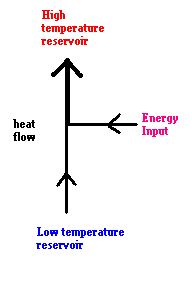



 animation
animation